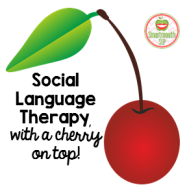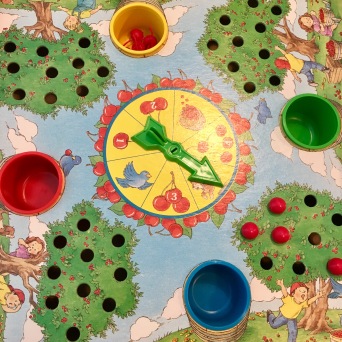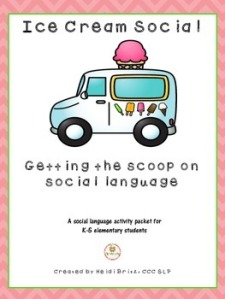
I work on the concepts of emotional identification and regulation in therapy with my kids a LOT! I love finding different ways of working on these skills, particularly using games. I also love the Zones of Regulation program for teaching and supporting these concepts. So when I find a way to combine the two, it’s a win! If you have ever played Hi Ho-Cherry-o! ™, you might have noticed that the bucket colors correspond to the primary colors (red, green, blue, yellow) that are also used in Zones. I know!!!

How do we use the game to work on emotional regulation? I am so glad you sort of, not really asked! Once you have introduced the Zones curriculum to your students and they have a good understanding of the concepts, then you can start to generalize the skills with this game. The spinner has cherries 1-4, a dog, a bird, and a spilled cherry basket icon. Each person’s tree holds 10 cherries, but we start the game with ten cherries in each bucket. Before we start the game, we talk about how each bucket color represents a category of emotions that correlate to Zones of Regulation. For example, the blue bucket can represent emotions such as sad, disappointed or tired. One the things I really like about the Zones program is that the authors help us understand that there are no bad emotions, it’s okay to experience them all in the right time and place. The Zones also teaches us how to regulate and match our reactions to these feelings.

Next, we spin the spinner and if we land on the cherries (1-4), we identify a situation that might make us have feelings in the zone we choose (example: identify 3 situations that might put us in the red zone- someone cutting in line, being yelled at or your brother taking your bike without asking). Then we put the corresponding cherries from the red bucket on the tree. If you land on the bird, you have to listen to a social-emotional scenario and decide if the reaction matches the level of emotion. Hello working on size of a problem and identifying the size of a reaction! If you land on the dog, you have to identify a strategy to help you move from red, yellow or blue zones back to the green zone (calm, happy). If you land on the spilled cherry bucket, we have to clear a tree of all the cherries on it (just one tree). This is a real time lesson on emotional regulation and dealing with frustration and disappointment! The goal of the game is to fill all the trees, empty the buckets and “grow” our social emotional learning. It’s emotional regulation with a cherry on top!
What other board games have you adapted to use for social language therapy? Share here!
